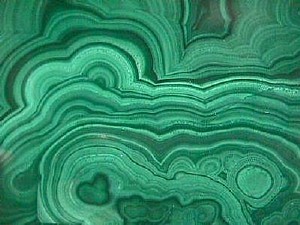Green Man
Spring 2014 – Summer 2016
SOLD
Model Name: Green Man
Color: Emerald Flame/Clear Shellac
Body Shape: Single-cut Carved Top
Body Material: Mahogany
Body Cap: Carved Flame Maple
Body Finish: Satin Shellac
Body Binding: Cream
Strap Buttons: Brass Dunlop Flush Fitting Straplok
Neck Type: Set Neck with All Access Joint
Neck Material: 3-Piece Mahogany (scarf joint)
Headstock Style: Classic 3×3
Neck Shape: Modern “C”
Neck Scale Length: 24.75”
Neck Binding: Cream
Headstock Binding: Cream
Nut: Brass
Nut Width: 44 mm
Fingerboard: Ebony
Fingerboard Radius: 14″
Number of Frets: 22
Fret Size: Jumbo (Dunlop 6100)
Fingerboard Inlays: N/A
Fingerboard Side Inlays: 3mm Brass Dots
Neck Pickup: Bare Knuckle Aftermath
Bridge Pickup: Bare Knuckle Aftermath
Controls:
- 1 x Master Volume, CTS 500K Coil-splitting potentiometer
- 1 x Master Tone, BKP 550K custom potentiometer
Pickup Switching: Classic 3-way Toggle
Hardware Finish: Vintage Copper
Bridge: Schaller STM
Tuning Machines: Schaller Da Vinci
Pickguard: N/A
Control Knobs: Knurled Brass Vintage Copper Finish
Switch Tips: Vintage Copper
Unique Features:
- Reconstituted Malachite ‘Matt Guest’ Runic Headstock Inlay
- Coil splitting function on push/pull Volume control
- Treble-bleed modification
The Green Man embodies the spirit of the forest and symbolises rebirth. This was my attempt to capture one of the most iconic and influential guitars of the modern era, Steve Vai’s Green Meanie. At the moment I am still building guitars to my own personal taste, so this project evolved into an interpretation of (in my opinion), the greatest electric guitar of all time, the ’59 Les Paul. The main aspect that differs from the original build of the ’59 is the neck-heel. Green Man features a rounded all-access-neck joint which gives very easy access to the upper register. The 3-piece mahogany neck has a full-feeling ‘C’ shape carve that really generates tone and sustain. Drawing from my personal preference, I have simplified the control layout to single Master and Tone for both pickups. Coil-splitting selection in the Master Volume allows instant single-coil Strat tones when required.
This has taken far longer than any of my other builds and feels like the best instrument I have worked on to date. I pondered over the headstock inlay design for many hours. It was originally intended to have an embodiment of the Green Man inlayed with Malachite, but limited resources meant that the result could have compromised the overall look and feel. In future builds I will revisit this design and utilise laser cutting technology to create the desired effect I have in my mind. As a result, the Green man guitar has a very reserved, simplistic finish which is reminiscent of the ’59 Les Paul.

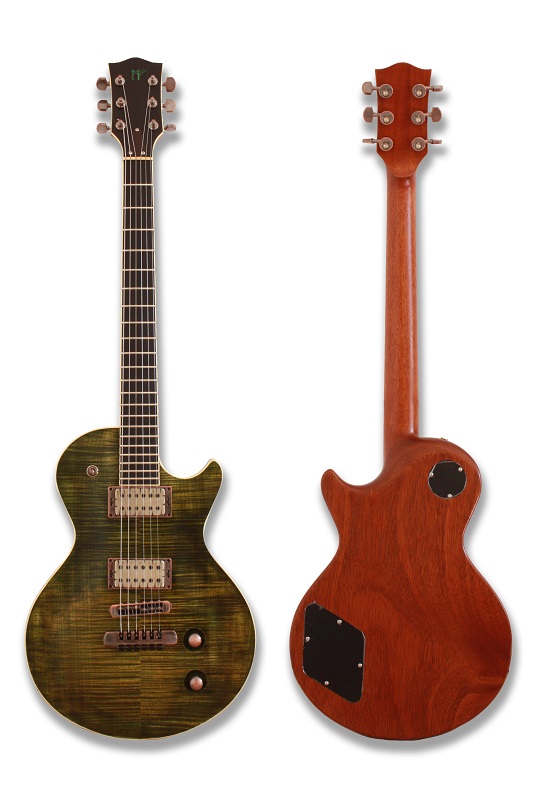
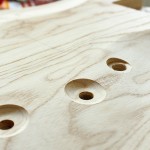 Green Man is going to be a classic single-cut carved top guitar which will feature Schaller brass control knobs. These are 18mm in diameter and around 15mm in height. Traditionally on Les Paul style carved-tops (from which Green Man is very much rooted), the neck control pots for volume and tone are placed on a heavy curve. Gibson don’t care too much about this, but Paul Reed Smith took some consideration for aesthetics and rightfully addressed the issue of the gradient creating a large gap under the control knob. PRS’ approach was to ‘scoop’ out the potentiometer hole so that the control knob actually sits in a little basin valley.
Green Man is going to be a classic single-cut carved top guitar which will feature Schaller brass control knobs. These are 18mm in diameter and around 15mm in height. Traditionally on Les Paul style carved-tops (from which Green Man is very much rooted), the neck control pots for volume and tone are placed on a heavy curve. Gibson don’t care too much about this, but Paul Reed Smith took some consideration for aesthetics and rightfully addressed the issue of the gradient creating a large gap under the control knob. PRS’ approach was to ‘scoop’ out the potentiometer hole so that the control knob actually sits in a little basin valley.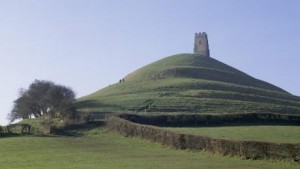
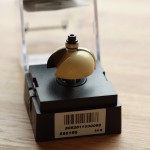
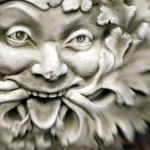 The primary delay of this project has been deciding on the headstock inlay. It has always been intended to be the head of the Pagan symbol Green Man, but I have laboured over the style and design for a long time.
The primary delay of this project has been deciding on the headstock inlay. It has always been intended to be the head of the Pagan symbol Green Man, but I have laboured over the style and design for a long time.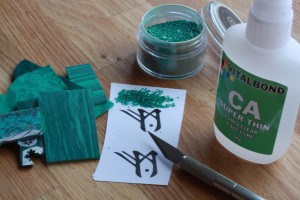
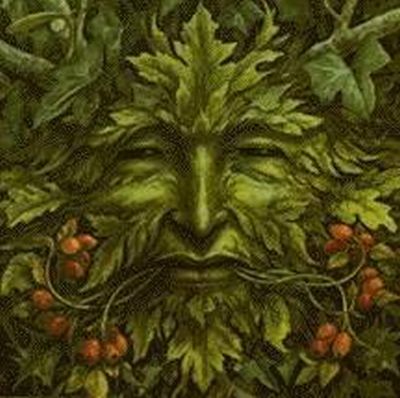
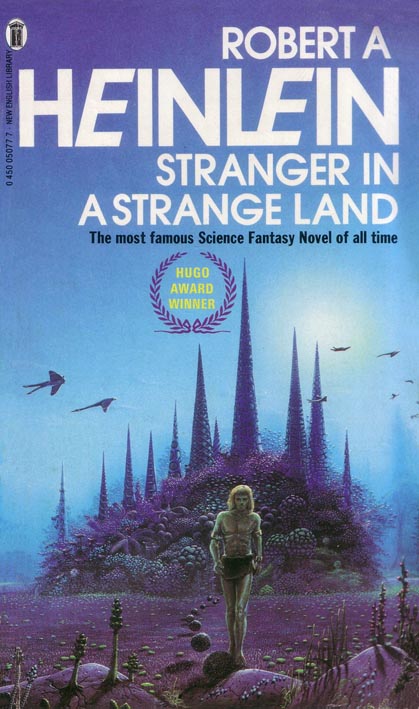




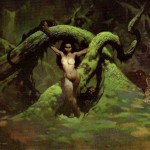
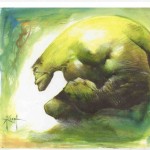
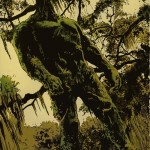
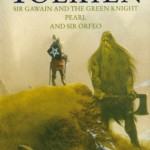
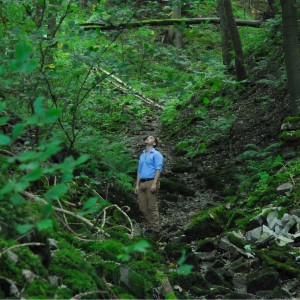
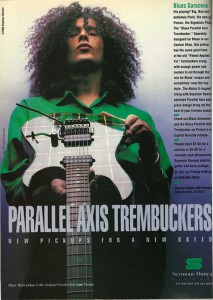
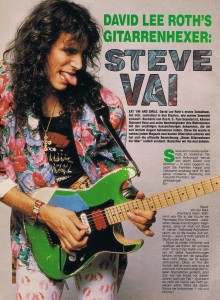 affectionately known as the Green Meanie. This was actually a Charvel manufactured guitar, so Ibanez would not be able to build an official replica tribute of this without stepping on someone’s toes. Vai had used this during his stint with Alcatrazz (it was a sunburst finish then before the ‘Loch-ness Green’ application) and more famously with David Lee Roth where he had carved out the lower horn to allow higher access to the fret-board (visible in the image on the left). As all the Jem guitars were built on the specifications of the Green meanie, it is a pretty iconic model.
affectionately known as the Green Meanie. This was actually a Charvel manufactured guitar, so Ibanez would not be able to build an official replica tribute of this without stepping on someone’s toes. Vai had used this during his stint with Alcatrazz (it was a sunburst finish then before the ‘Loch-ness Green’ application) and more famously with David Lee Roth where he had carved out the lower horn to allow higher access to the fret-board (visible in the image on the left). As all the Jem guitars were built on the specifications of the Green meanie, it is a pretty iconic model.
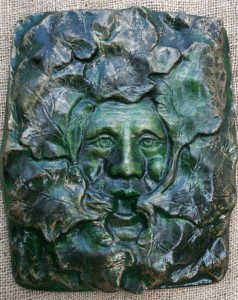 e project in keeping with my
e project in keeping with my 